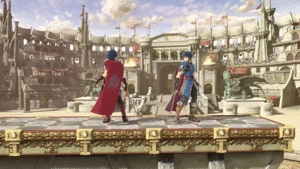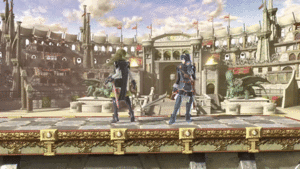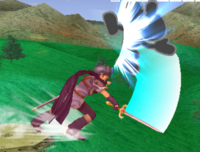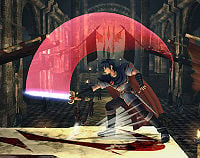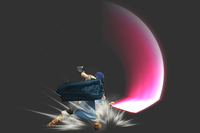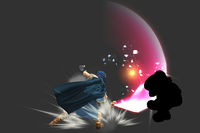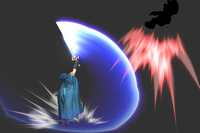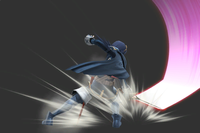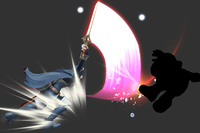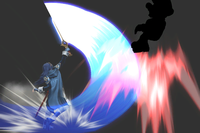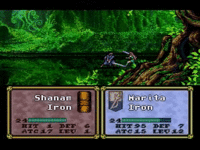Dancing Blade: Difference between revisions
mNo edit summary |
m (→Trivia: SmashPedia link.) |
||
| (97 intermediate revisions by 57 users not shown) | |||
| Line 1: | Line 1: | ||
{{ArticleIcons|melee= | {{ArticleIcons|melee=y|brawl=y|ssb4=y|ultimate=y}} | ||
:''For other pages with the name '''Blade''', see [[Blade (disambiguation)]].'' | |||
{{Infobox Special Move | {{Infobox Special Move | ||
|name=Dancing Blade | |name=Dancing Blade | ||
|image=[[File: | |image={{tabber|title1=Marth|content1=[[File:Marth Side B SSBU.gif|300px]]|title2=Lucina|content2=[[File:Lucina Side B SSBU.gif|300px]]}} | ||
|caption= | |caption=Dancing Blade in ''Super Smash Bros. Ultimate''. | ||
|user=[[Marth]] | |user=[[Marth]] | ||
|universe= | |user2=[[Lucina]] | ||
|universe={{uv|Fire Emblem}} | |||
}} | }} | ||
'''Dancing Blade''' ({{ja|マーベラスコンビネーション|Māberasu Konbinēshon}}, ''Marvelous Combination'') is [[Marth]] and [[Lucina]]'s [[side special move]]. | |||
[[Roy]] and [[Chrom]]'s [[Double-Edge Dance]] is a variant of this attack, which also shares the same Japanese, Chinese and Korean name. | |||
==Overview== | |||
When used, the user performs a sideways slash, which can be followed by up to three more hits with further presses of the [[special]] button. Tilting the [[control stick]] in a specific direction during the execution of any slash but the first changes its trajectory and properties: the second hit can be tilted forward or up, while the third and fourth hit can be tilted up, forward or down. Counting all hits, there is a total of 18 possible combinations. | |||
==In ''[[Super Smash Bros. Melee]]''== | ===In ''[[Super Smash Bros. Melee]]''=== | ||
:{{Main|Marth (SSBM)/Side special}} | |||
[[File:Dancingblade.png|thumb|Dancing Blade in ''Melee''.|left]] | [[File:Dancingblade.png|thumb|Dancing Blade in ''Melee''.|left]] | ||
In ''Melee'', the first attack is often used to gain horizontal recovery. | In ''Melee'', the first attack is often used to gain horizontal recovery. Marth glows a color as he uses his attacks: red in the first attack, green in the second, blue in the third, and red again for the fourth. It is quite unlikely that Marth would have to use all four attacks, since both the third and fourth strikes have much higher [[knockback]] than the first and second. It is rather difficult to pull off the full attack, as the attack requires timing on each blow to follow up. | ||
{{clrl}} | |||
===In ''[[Super Smash Bros. Brawl]]''=== | |||
==In ''[[Super Smash Bros. Brawl]]''== | |||
[[File:Dancingblade.jpg|thumb|Dancing Blade in ''Brawl''.]] | [[File:Dancingblade.jpg|thumb|Dancing Blade in ''Brawl''.]] | ||
Dancing Blade has seen quite a few changes since ''Melee''. Unlike in ''Melee'', Marth | Dancing Blade has seen quite a few changes since ''Melee''. Unlike in ''Melee'', Marth does not glow when using this attack. Instead, the motion trail of his sword changes depending on the direction tilted, with Red always representing neutral, Blue always representing up, and Green always representing down. Secondly, the timing no longer matters, so it can be performed easily. If the first hit connects, it is nearly impossible to escape the rest of the combo when the timing is fast enough. The knockback on the third strike is decreased, allowing for better combos. The final can either be 2 [[KO]] moves at high percentages (Up can KO at 118% tipped, 142% base. Forward can KO at 140% tipped, 179% base) or a quick damage racker (Down can KO at 213% [[Tipper|tipped]], 305% base), while the upward final strike has a brand new animation (a turning upward flick as opposed to a turning slam-slash in ''Melee''). | ||
===Reverse Dancing Blade=== | |||
In ''Brawl'', Marth's Dancing Blade can be reversed by tapping the control stick in the opposite direction a few frames after the side special move has been activated. There is no increase to damage, knockback and has no reverse animation, | The third hit is still a [[meteor smash]], but only if not sweetspotted. However, the move aids Marth's recovery less than the previous game. The damages for the first hit is 3% (4% tipped), both the second hits are also 3% (4% tipped), all the third hits are 4% (5% tipped) and the last up and forward hits are both 6% (8% tipped) while the total of the multiple down hits are 11% (13% tipped). | ||
====Reverse Dancing Blade==== | |||
In ''Brawl'', Marth's Dancing Blade can be reversed by tapping the control stick in the opposite direction a few frames after the side special move has been activated. There is no increase to damage, knockback and has no reverse animation, which makes reversing useful only if it is used to attack behind Marth. However, since Dancing Blade is so quick, it looks like there is a slight animation of Marth turning around, though it is actually the start of the animation of a normal Dancing Blade that continues on the other side when Marth turns around. | |||
<br clear=right> | <br clear=right> | ||
===In ''[[Super Smash Bros. 4]]''=== | |||
Dancing Blade returns in ''Super Smash Bros. 4'' as {{SSB4|Marth}}'s side special move, as well as that of his [[clone]], {{SSB4|Lucina}}. Visually, the [[tipper|tip]] of the sword in Marth's version glows more brightly than the rest of the trail, while Lucina's is a full bright white blur all along her blade, indicating the move's consistent damage across the entire blade (much like most of her other sword attacks). The attack generally deals more damage when angled downward, but has more ending lag, and the downward-angled third hit no longer meteor smashes. Additionally, it is much easier to escape out of, due to the move's lowered hitstun, less interruptibility, and its tendency to throw opponents out of the move even if the first hit connects. Overall, the move is now less effective than in ''Brawl'', although the changes to the move's knockback angles in the [[1.1.3]] update made the attack easier to chain together, making it more effective than how it was initially. | |||
===In ''[[Super Smash Bros. Ultimate]]''=== | |||
Dancing Blade returns in ''Super Smash Bros. Ultimate'' as {{SSBU|Marth}} and {{SSBU|Lucina}}'s side special move, and has again received some significant changes. Each swing transitions significantly faster than before and can thus be [[buffer]]ed, making the move easier to connect with every hit. Every swing has an altered animation. However, the user does not step forward as much after each swing, reducing the move's effective range, and the first swing has slightly longer startup. | |||
==Instructional quotes== | |||
{{InstructionalQuotes | |||
|ssbmtrophychar=Marth | |||
|ssbmtrophydesc=The Dancing Blade combination uses both the Control Stick and the B Button to produce a series of up to four attacks. | |||
|ssb4-3char=Marth | |||
|ssb4-3desc=A combo that you can change by sliding {{button|3DS|Circle Pad}} up or down. Can hit four times. | |||
|ssbucount=2 | |||
|ssbuchar=Marth | |||
|ssbudesc=Slashes opponents up to four times, with repeated button presses. Tilting up and down can change each attack. | |||
|ssbuchar2=Lucina | |||
|ssbudesc2=Slashes opponents up to four times, with repeated button presses. Tilting up and down can change each attack. | |||
}} | |||
==Customization== | |||
Special Move customization was added in ''[[Super Smash Bros. 4]]''. These are the variations: | |||
{{CustomSet|Marth|Side|name1=Dancing Blade|desc1=Press repeatedly to unleash a sword combo. Press up or down to change the attacks.|name2=Effortless Blade|desc2=You can't change the combo type, but you can wait longer between attacks. Lower damage.|name3=Heavy Blade|desc3=Each strike is stronger but launches foes, making it hard to pull off a combo.}} | |||
{{CustomSet|Lucina|Side|name1=Dancing Blade|desc1-ntsc=Attack up to four times. Press up or down to change the combo type.|desc1-pal=Strikes with your sword. Press repeatedly for a combo. Vary the strikes by inputting up or down.|name2=Effortless Blade|desc2-ntsc=You can't change the combo type, but you can wait longer between attacks. Lower damage.|desc2-pal=Hits four times even without careful timing, but the strikes are always the same and hurt less.|name3=Heavy Blade|desc3-ntsc=Each strike is stronger but launches foes, making it hard to pull off a combo.|desc3-pal=Each attack's power is much stronger, but can't be used as a combo since they launch foes.}} | |||
# '''Dancing Blade''': Default. | |||
# '''Effortless Blade''': Expands window for button input, but only allows forward swings while dealing less damage and knockback. | |||
#: In {{for3ds}}, this variation is a [[List of challenges (SSB4-3DS)|Challenge]] unlock, only obtainable by clearing [[100-Man Smash]] in less than 3 minutes.{{Main|Marth (SSB4)/Side special/Custom 1}}{{Main|Lucina (SSB4)/Side special/Custom 1}} | |||
# '''Heavy Blade''': Deals much more damage and knockback, and the slashes have more range; the first swing has enough knockback to be a viable KO move, and the final swings are all capable of KOing at very low percentages. However, the input timing is more strict while the hits are slower, with the resultant increase in knockback also making each separate hit almost impossible to link together.{{Main|Marth (SSB4)/Side special/Custom 2}}{{Main|Lucina (SSB4)/Side special/Custom 2}} | |||
==Origin== | ==Origin== | ||
Dancing Blade loosely resembles the [[fireemblemwiki:Astra (skill)|Astra skill]], which allows its users to unleash five consecutive blows upon an enemy when activated. Astra does not exist in any of Marth's four native games, as the skill system debuted in ''{{s|fireemblemwiki|Fire Emblem: Genealogy of the Holy War}}'' after Marth's original two games and was not included in the Nintendo DS remakes, | [[File:Dancing Blade origin.gif|thumb|{{s|fireemblemwiki|Mareeta}} using Astra against {{s|fireemblemwiki|Shanam}} in ''Fire Emblem: Thracia 776''.]] | ||
Dancing Blade loosely resembles the [[fireemblemwiki:Astra (skill)|Astra skill]], which allows its users to unleash five consecutive blows upon an enemy when activated. Originally simply allowing for five strikes with no drawbacks, it has received various nerfs throughout the series, such as reduced damage per blow, removing the ability to land a critical hit, and removing the ability to make a follow-up attack. Despite this, Astra is commonly seen as one of the most powerful offensive skills in the series. | |||
Astra does not exist in any of Marth's four native games, as the skill system debuted in ''{{s|fireemblemwiki|Fire Emblem: Genealogy of the Holy War}}'' after Marth's original two games and was not included in the Nintendo DS remakes, though the skill itself was introduced prior to ''Melee''. Despite this, Marth's [[fireemblemwiki:Marth#Downloadable content|"King Marth"]] [[fireemblemwiki:Bonus units|bonus unit]] incarnation in ''{{s|fireemblemwiki|Fire Emblem Awakening}}'' possesses Astra as a default skill, likely as a reference to ''Smash''. Lucina is also able to obtain Astra through reclassing if her mother is [[Robin|a female Avatar]], {{s|fireemblemwiki|Sully}}, or {{s|fireemblemwiki|Olivia}}. In their default classes in ''Awakening'', {{s|fireemblemwiki|Lord}} and {{s|fireemblemwiki|Lodestar}} respectively, Lucina and Marth's motions while using it are a strong visual parallel to the Dancing Blade motions in the ''Smash Bros.'' series. Any character in ''Awakening'' can also use Astra if {{s|fireemblemwiki:Astra (weapon)|the bow of the same name}} is equipped. In ''Fates'', Lucina and Marth use similar motions to Dancing Blade in their regular attack animations. In ''{{s|fireemblemwiki|Fire Emblem Engage}}'', Lodestar Rush is a combat skill for Emblem Marth which can be used by any unit equipped with his Emblem Ring while engaged. | |||
The English version of ''{{s|fireemblemwiki|Fire Emblem Fates}}'' went on to give the [[amiibo]] incarnation of Marth and his Lodestar class a skill named {{s|fireemblemwiki|Dancing Blade}} after the ''Super Smash Bros.'' move. The French, Italian, and Spanish translations also made this reference. However, this was likely not originally intended to be a direct reference, as it has a different Japanese name ("Gentle Blade") and an unrelated effect, granting the user +3 to their Speed stat but -1 to their Defense stat. The skill's English name would later be changed to ''Flashing Blade'' in ''{{s|fireemblemwiki|Fire Emblem Heroes}}'' alongside the other languages, accelerating cooldown for special skills by 1 point per attack if the user is faster. | |||
{{clr}} | |||
==Gallery== | ==Gallery== | ||
<gallery widths="200x200"> | <gallery widths="200x200"> | ||
Dancing Blade.png|The first strike of Dancing Blade in ''Brawl''. | |||
SSB4_Marth Screen-8.jpg|The final forward strike of Marth's Dancing Blade in ''SSB4''. | |||
LucinaDancingBlade.png|The final strike of Lucina's Dancing Blade tilted forward in ''Smash 4''. | |||
LucinaDancingBlade2.png|Lucina attacking {{SSB4|Link}} with the final downward hit of Dancing Blade. | |||
SSB4-3DS challenge image P3R2C3.png|Challenge board unlock image for Effortless Blade. | |||
Marth SSBU Skill Preview Side Special.png|Marth using Dancing Blade as shown by the Move List in ''Ultimate''. | |||
Lucina SSBU Skill Preview Side Special.png|Lucina using Dancing Blade as shown by the Move List in ''Ultimate''. | |||
</gallery> | |||
==Names in other languages== | |||
{{langtable | |||
|ja={{ja|マーベラスコンビネーション|Māberasu Konbinēshon}}, ''Marvelous Combination'' | |||
|en=Dancing Blade | |||
|fr=Épée dansante | |||
|es=Danza del sable | |||
|de=Tanz-Klinge | |||
|it=Lame danzanti | |||
|nl=Dansend Zwaard | |||
|ru={{rollover|Танцующий клинок|Tantsuyushchy klinok|?}} | |||
|ko={{rollover|댄싱 블레이드|Daensing Beulleideu|?}}, ''Dancing Blade'' | |||
|zh_cn={{rollover|炫光剑舞|Xuàn Guāng Jiàn Wǔ|?}} | |||
|zh_tw={{rollover|炫光劍舞|Xuàn Guāng Jiàn Wǔ|?}} | |||
}} | |||
==Trivia== | ==Trivia== | ||
*By repeatedly using the first attack of Dancing Blade, Marth can rise into the air during a Tiny, Light Special Brawl or in the Flying transformation of [[Pokémon Stadium 2]]. | *By repeatedly using the first attack of Dancing Blade, Marth can rise into the air during a Tiny, Light Special Brawl or in the Flying transformation of [[Pokémon Stadium 2]]. | ||
*Falling off a conveyor belt while using the first, the third or the forward version of the fourth attack gives Marth great horizontal acceleration. The attack that makes him fastest is the up version of the third attack. Note that this works not only for Marth, but is most noticeable with him. | *Falling off a conveyor belt while using the first, the third or the forward version of the fourth attack gives Marth great horizontal acceleration. The attack that makes him fastest is the up version of the third attack. Note that this works not only for Marth, but is most noticeable with him. | ||
*Marth is unable to do any other hits than the first slash | *In ''Melee'' through ''SSB4'', Marth is unable to do any other hits than the first slash if he has too much sideways momentum in the air. | ||
*Like [[Dolphin Slash]], the sound of Dancing Blade varies between versions, except that the differences are less apart from each other. ''Brawl'''s version includes loud slash sound effects while the ''Smash 4'' version is significantly quieter. | |||
*In ''SSB4'', the third hit of an aerial Dancing Blade aimed upward or downward will use their ''Melee'' animations (swinging downwards for the former, and a downward stab with a twirl for the latter), despite the move being given new animations for their grounded versions. | |||
*Dancing Blade and [[Double-Edge Dance]] have the unique distinction in ''Smash'' of being two of the only attacks that can be considered a "Rekka". In fighting game terminology, a "Rekka" refers to a [[Special move|command input attack]] that allows for [[Natural combo|multiple follow-ups through additional command inputs]], often times having a "branching path" of available attacks and options. They are traditionally utilized for combo extensions and to hit-confirm into mixups. The name is derived from the [https://streetfighter.fandom.com/wiki/Rekkaken Rekkaken], one of the signature attacks of {{s|wikipedia|Fei Long}} from the {{uv|Street Fighter}} series, who originated this type of attack. | |||
{{Multiple Special Moves|Marth|Lucina}} | {{Multiple Special Moves|Marth|Lucina}} | ||
| Line 48: | Line 109: | ||
[[Category:Side special moves]] | [[Category:Side special moves]] | ||
[[Category:Marth]] | [[Category:Marth]] | ||
[[Category:Marth (SSBM)]] | |||
[[Category:Marth (SSBB)]] | |||
[[Category:Marth (SSB4)]] | |||
[[Category:Marth (SSBU)]] | |||
[[Category:Lucina]] | [[Category:Lucina]] | ||
[[Category:Lucina (SSB4)]] | |||
[[Category:Lucina (SSBU)]] | |||
[[es:Danza del sable]] | |||
Latest revision as of 00:24, March 16, 2024
- For other pages with the name Blade, see Blade (disambiguation).
| Dancing Blade | |
|---|---|
Dancing Blade in Super Smash Bros. Ultimate. | |
| Users | Marth Lucina |
| Universe | Fire Emblem |
Dancing Blade (マーベラスコンビネーション, Marvelous Combination) is Marth and Lucina's side special move.
Roy and Chrom's Double-Edge Dance is a variant of this attack, which also shares the same Japanese, Chinese and Korean name.
Overview[edit]
When used, the user performs a sideways slash, which can be followed by up to three more hits with further presses of the special button. Tilting the control stick in a specific direction during the execution of any slash but the first changes its trajectory and properties: the second hit can be tilted forward or up, while the third and fourth hit can be tilted up, forward or down. Counting all hits, there is a total of 18 possible combinations.
In Super Smash Bros. Melee[edit]
In Melee, the first attack is often used to gain horizontal recovery. Marth glows a color as he uses his attacks: red in the first attack, green in the second, blue in the third, and red again for the fourth. It is quite unlikely that Marth would have to use all four attacks, since both the third and fourth strikes have much higher knockback than the first and second. It is rather difficult to pull off the full attack, as the attack requires timing on each blow to follow up.
In Super Smash Bros. Brawl[edit]
Dancing Blade has seen quite a few changes since Melee. Unlike in Melee, Marth does not glow when using this attack. Instead, the motion trail of his sword changes depending on the direction tilted, with Red always representing neutral, Blue always representing up, and Green always representing down. Secondly, the timing no longer matters, so it can be performed easily. If the first hit connects, it is nearly impossible to escape the rest of the combo when the timing is fast enough. The knockback on the third strike is decreased, allowing for better combos. The final can either be 2 KO moves at high percentages (Up can KO at 118% tipped, 142% base. Forward can KO at 140% tipped, 179% base) or a quick damage racker (Down can KO at 213% tipped, 305% base), while the upward final strike has a brand new animation (a turning upward flick as opposed to a turning slam-slash in Melee).
The third hit is still a meteor smash, but only if not sweetspotted. However, the move aids Marth's recovery less than the previous game. The damages for the first hit is 3% (4% tipped), both the second hits are also 3% (4% tipped), all the third hits are 4% (5% tipped) and the last up and forward hits are both 6% (8% tipped) while the total of the multiple down hits are 11% (13% tipped).
Reverse Dancing Blade[edit]
In Brawl, Marth's Dancing Blade can be reversed by tapping the control stick in the opposite direction a few frames after the side special move has been activated. There is no increase to damage, knockback and has no reverse animation, which makes reversing useful only if it is used to attack behind Marth. However, since Dancing Blade is so quick, it looks like there is a slight animation of Marth turning around, though it is actually the start of the animation of a normal Dancing Blade that continues on the other side when Marth turns around.
In Super Smash Bros. 4[edit]
Dancing Blade returns in Super Smash Bros. 4 as Marth's side special move, as well as that of his clone, Lucina. Visually, the tip of the sword in Marth's version glows more brightly than the rest of the trail, while Lucina's is a full bright white blur all along her blade, indicating the move's consistent damage across the entire blade (much like most of her other sword attacks). The attack generally deals more damage when angled downward, but has more ending lag, and the downward-angled third hit no longer meteor smashes. Additionally, it is much easier to escape out of, due to the move's lowered hitstun, less interruptibility, and its tendency to throw opponents out of the move even if the first hit connects. Overall, the move is now less effective than in Brawl, although the changes to the move's knockback angles in the 1.1.3 update made the attack easier to chain together, making it more effective than how it was initially.
In Super Smash Bros. Ultimate[edit]
Dancing Blade returns in Super Smash Bros. Ultimate as Marth and Lucina's side special move, and has again received some significant changes. Each swing transitions significantly faster than before and can thus be buffered, making the move easier to connect with every hit. Every swing has an altered animation. However, the user does not step forward as much after each swing, reducing the move's effective range, and the first swing has slightly longer startup.
Instructional quotes[edit]
| The Dancing Blade combination uses both the Control Stick and the B Button to produce a series of up to four attacks. | ||
| A combo that you can change by sliding | ||
| Slashes opponents up to four times, with repeated button presses. Tilting up and down can change each attack. | ||
| Slashes opponents up to four times, with repeated button presses. Tilting up and down can change each attack. |
Customization[edit]
Special Move customization was added in Super Smash Bros. 4. These are the variations:
| 1. Dancing Blade | 2. Effortless Blade | 3. Heavy Blade |
|---|---|---|
| "Press repeatedly to unleash a sword combo. Press up or down to change the attacks." | "You can't change the combo type, but you can wait longer between attacks. Lower damage." | "Each strike is stronger but launches foes, making it hard to pull off a combo." |
- Dancing Blade: Default.
- Effortless Blade: Expands window for button input, but only allows forward swings while dealing less damage and knockback.
- In Super Smash Bros. for Nintendo 3DS, this variation is a Challenge unlock, only obtainable by clearing 100-Man Smash in less than 3 minutes.
- Heavy Blade: Deals much more damage and knockback, and the slashes have more range; the first swing has enough knockback to be a viable KO move, and the final swings are all capable of KOing at very low percentages. However, the input timing is more strict while the hits are slower, with the resultant increase in knockback also making each separate hit almost impossible to link together.
Origin[edit]
Dancing Blade loosely resembles the Astra skill, which allows its users to unleash five consecutive blows upon an enemy when activated. Originally simply allowing for five strikes with no drawbacks, it has received various nerfs throughout the series, such as reduced damage per blow, removing the ability to land a critical hit, and removing the ability to make a follow-up attack. Despite this, Astra is commonly seen as one of the most powerful offensive skills in the series.
Astra does not exist in any of Marth's four native games, as the skill system debuted in Fire Emblem: Genealogy of the Holy War after Marth's original two games and was not included in the Nintendo DS remakes, though the skill itself was introduced prior to Melee. Despite this, Marth's "King Marth" bonus unit incarnation in Fire Emblem Awakening possesses Astra as a default skill, likely as a reference to Smash. Lucina is also able to obtain Astra through reclassing if her mother is a female Avatar, Sully, or Olivia. In their default classes in Awakening, Lord and Lodestar respectively, Lucina and Marth's motions while using it are a strong visual parallel to the Dancing Blade motions in the Smash Bros. series. Any character in Awakening can also use Astra if the bow of the same name is equipped. In Fates, Lucina and Marth use similar motions to Dancing Blade in their regular attack animations. In Fire Emblem Engage, Lodestar Rush is a combat skill for Emblem Marth which can be used by any unit equipped with his Emblem Ring while engaged.
The English version of Fire Emblem Fates went on to give the amiibo incarnation of Marth and his Lodestar class a skill named Dancing Blade after the Super Smash Bros. move. The French, Italian, and Spanish translations also made this reference. However, this was likely not originally intended to be a direct reference, as it has a different Japanese name ("Gentle Blade") and an unrelated effect, granting the user +3 to their Speed stat but -1 to their Defense stat. The skill's English name would later be changed to Flashing Blade in Fire Emblem Heroes alongside the other languages, accelerating cooldown for special skills by 1 point per attack if the user is faster.
Gallery[edit]
Lucina attacking Link with the final downward hit of Dancing Blade.
Names in other languages[edit]
Trivia[edit]
- By repeatedly using the first attack of Dancing Blade, Marth can rise into the air during a Tiny, Light Special Brawl or in the Flying transformation of Pokémon Stadium 2.
- Falling off a conveyor belt while using the first, the third or the forward version of the fourth attack gives Marth great horizontal acceleration. The attack that makes him fastest is the up version of the third attack. Note that this works not only for Marth, but is most noticeable with him.
- In Melee through SSB4, Marth is unable to do any other hits than the first slash if he has too much sideways momentum in the air.
- Like Dolphin Slash, the sound of Dancing Blade varies between versions, except that the differences are less apart from each other. Brawl's version includes loud slash sound effects while the Smash 4 version is significantly quieter.
- In SSB4, the third hit of an aerial Dancing Blade aimed upward or downward will use their Melee animations (swinging downwards for the former, and a downward stab with a twirl for the latter), despite the move being given new animations for their grounded versions.
- Dancing Blade and Double-Edge Dance have the unique distinction in Smash of being two of the only attacks that can be considered a "Rekka". In fighting game terminology, a "Rekka" refers to a command input attack that allows for multiple follow-ups through additional command inputs, often times having a "branching path" of available attacks and options. They are traditionally utilized for combo extensions and to hit-confirm into mixups. The name is derived from the Rekkaken, one of the signature attacks of Fei Long from the Street Fighter series, who originated this type of attack.
